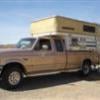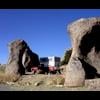
Stuck & Un-stuck -- Safely
#11

Posted 12 December 2011 - 01:39 AM
The basics that I carry for solo travel are:
good shovel
expensive air compressor and tire deflator
bridging/traction ladders
kinetic recovery/snatch strap
EDIT: tire repair kit
www.KuenzliPhotography.com
2012 Four Wheel Camper - The FWC Build
"If life was fair, Utah would be closer to home" DD
#12

Posted 12 December 2011 - 01:49 AM
Ah not sure why you're quoting me there...

As for pulling with a chain, unless it's a slow/steady application of force I would never use one. So to me that is limited to winching, never for pulling a vehicle out. Plus way to much weight for a reasonable length/thickness verse a strap.
Yeh, didn't mean it that way, straps break all the time, and not being in the way when they break, thought this was more about talking about what to do out there! As to chains they usually don't break, cables and straps do!, I thought this thread was about safety and how to survive, slow and steady is right, but a jerk (not the person-who got stuck or me or you) at the right time may work, but taking a walk and thinking about what to next is a lot better than getting pissed and doing something than gets you stuck even deeper: been stuck enough times to know that!
that Okay!
Smoke:rolleyes:
#13

Posted 12 December 2011 - 04:45 AM
First; straps with metal hooks should be left where you see them. Do not buy one, not for any use or reason. Like tow balls, those hooks also have the potential to become extremely dangerous projectiles. If one is available sooner or later it will be misused. Sort of like how Professional race car prep shops never have Grade 5 bolts on hand. Sooner or later someone will put one in a highly stressed location and cause a failure.
Second; there are the two types of straps already mentioned, static and dynamic. Dynamic straps stretch under load and are for using one vehicle to yank another out of a stuck. Static straps do not stretch under load and would be potentially dangerous if used "dynamically." However, static straps are useful for rigging in place of chains. Look for lifting slings used in moving freight etc. I would strongly suggest that if a static strap is purchased that it deliberately be of a type that is not similar to the common dynamic strap, i.e. a flat strap. Buy a round static strap so that identifying which is which is a simple thing. Using a mooring line of sufficient strength is a good static 'strap' solution. I recently read a post about reducing the "frustration factor" and I would place this type of decision in that realm. If a static strap is acquired an aspect of their use where a chain is a better choice is if abrasive conditions are reasonable to expect. Such as needing to put a loop around volcanic rocks as an anchor. Nothing really beats chains in this type of use.
Third; One group of guys that I'm frequently off road with all use 3" straps even though they all have relatively light rigs. Their reason is that, while more dynamic, 2" straps do not last as long. I'm not sure why this is, but I've seen & experienced it to be true.
There are two lengths of Hi-Lifts offered. The 48" long version carried by everyone that is mostly sold to Jeep owners, and the much more usable 60" version that is harder to find.
In cold country I keep in mind what a native in Freedonia, AZ told me as we were heading to Toroweep one February. "If you get stuck in the mud just wait until it freezes. Then you'll be able to drive right out." I don't know that this works, but given his obvious experience from living in that area I'm inclined to try it. Beats walking out.
I've been told by a guy who'd tried all types of limited slips that the light braking technique works the best with the all-gear type LSD's. Not that it doesn't work with the others, just that it's the most effective with those.
Commercial marine vendors have lines like the Samson's Amsteel and Amsteel Blue. 1/4" Amsteel Blue has an average breaking strength of 8,600 lbs and a minimum breaking strength of 7,700 lbs. Strength for size makes this type of line very appealing. 1/2" Blue has a minimum breaking strength of 30,600 lbs.!
Knots are tricky in this stuff, they tend to be stress concentrators which results in localized heat when loaded. Doesn't take much load thru a knot to part the line and the resulted parting looks like someone used a propane torch there. This I learned by intentionally repeatedly failing some 1/4" Amsteel line using a Warn 8274 winch to pull on it. A simple braiding works much, much better than a knot. These are a 12 strand braid rather than a laid line. They tend to behave a bit like a "chinese finger trap" and exploiting this is the key. On one end a spliced eyelet is a good idea, but to be able to rig at varying lengths without knots requires a fid or a pencil. Simply piercing the 'live' portion of the line between the strands horizontally several times while weaving the 'dead' end of the line in an 'S' shape thru those piercings worked a trick!
I've been seeing occasional mentions of using a tow ball as an attachment point to pull someone out. That is a very, very bad practice. Dynamic loads like that use are known to fail the balls which turns them into a projectile flying inline to the strap's direction. Think about what is along that line of action and then consider that such balls have completely penetrated sheet metal, like opened hoods. When the pull direction will allow it you can simply insert the strap into a receiver hitch and run the slider's pin thru the strap's loop. The problem with this is that any sort of angle between the strap and the hitch opening puts the strap at risk of being cut by the receiver's opening. For off-angle pulls a slider that accepts a shackle is a simple & very worthwhile piece of gear.
http://www.warn.com/truck/accessories/shackle.shtml Most buy theirs, I made mine and made it much more complicated than it needed to be just to take some weight out of it.
Where does that road go?
#14

Posted 12 December 2011 - 07:02 AM
I'm going to quote myself from the previous thread, but first I'd like to revisit the straps discussion.
First; straps with metal hooks should be left where you see them. Do not buy one, not for any use or reason. Like tow balls, those hooks also have the potential to become extremely dangerous projectiles. If one is available sooner or later it will be misused. Sort of like how Professional race car prep shops never have Grade 5 bolts on hand. Sooner or later someone will put one in a highly stressed location and cause a failure.
Second; there are the two types of straps already mentioned, static and dynamic. Dynamic straps stretch under load and are for using one vehicle to yank another out of a stuck. Static straps do not stretch under load and would be potentially dangerous if used "dynamically." However, static straps are useful for rigging in place of chains. Look for lifting slings used in moving freight etc. I would strongly suggest that if a static strap is purchased that it deliberately be of a type that is not similar to the common dynamic strap, i.e. a flat strap. Buy a round static strap so that identifying which is which is a simple thing. Using a mooring line of sufficient strength is a good static 'strap' solution. I recently read a post about reducing the "frustration factor" and I would place this type of decision in that realm. If a static strap is acquired an aspect of their use where a chain is a better choice is if abrasive conditions are reasonable to expect. Such as needing to put a loop around volcanic rocks as an anchor. Nothing really beats chains in this type of use.
Third; One group of guys that I'm frequently off road with all use 3" straps even though they all have relatively light rigs. Their reason is that, while more dynamic, 2" straps do not last as long. I'm not sure why this is, but I've seen & experienced it to be true.
YEP, lets keep this going, I bury the handyman and winch from there, or hook it up to something, still like my old chain, because the straps can be as bad as a cable if they break, but what ever works, is what counts! Really, am interested in that black rat hand winch, will it work with a buried handyman, or by it self--==-have always been afraid of using the bumper wench, but have, many times and hide behind the truck, or of late, pop up the hood on the truck,and hide behind it and then winch-did that a few years ago with the BLM-felt safe, but sorta felt wimpy-but safe!
smoke
#15

Posted 12 December 2011 - 07:13 AM
I'm going to quote myself from the previous thread, but first I'd like to revisit the straps discussion.
First; straps with metal hooks should be left where you see them. Do not buy one, not for any use or reason. Like tow balls, those hooks also have the potential to become extremely dangerous projectiles. If one is available sooner or later it will be misused. Sort of like how Professional race car prep shops never have Grade 5 bolts on hand. Sooner or later someone will put one in a highly stressed location and cause a failure.
Second; there are the two types of straps already mentioned, static and dynamic. Dynamic straps stretch under load and are for using one vehicle to yank another out of a stuck. Static straps do not stretch under load and would be potentially dangerous if used "dynamically." However, static straps are useful for rigging in place of chains. Look for lifting slings used in moving freight etc. I would strongly suggest that if a static strap is purchased that it deliberately be of a type that is not similar to the common dynamic strap, i.e. a flat strap. Buy a round static strap so that identifying which is which is a simple thing. Using a mooring line of sufficient strength is a good static 'strap' solution. I recently read a post about reducing the "frustration factor" and I would place this type of decision in that realm. If a static strap is acquired an aspect of their use where a chain is a better choice is if abrasive conditions are reasonable to expect. Such as needing to put a loop around volcanic rocks as an anchor. Nothing really beats chains in this type of use.
Third; One group of guys that I'm frequently off road with all use 3" straps even though they all have relatively light rigs. Their reason is that, while more dynamic, 2" straps do not last as long. I'm not sure why this is, but I've seen & experienced it to be true.
YEP, lets keep this going, I can bury the handyman and winch from there, or hook it up to something, still like my old chain, because the straps can be as bad as a cable if they break, but what ever works, is what counts! Learned how to use a winch in the army, like in 1965, still scares me. Really, am interested in that black rat hand winch, will it work with a buried handyman, or by it self--==-have always been afraid of using the bumper wench, but have, many times and hide behind the truck, or of late, pop up the hood on the truck,and hide behind it and then winch-did that a few years ago with the BLM-felt safe, but sorta felt wimpy-but safe!
smoke
#16

Posted 12 December 2011 - 02:07 PM
What works is what is used.
2-expensive 12vdc air compressors
50 cal. ammo can, " filled" with tire repairs. Camel brand stuff from Napa.
Hi-lift
Several 2x6's
2" 30' strap
I forgot all about the E-brake usage. Heard it many years ago, but forgot.
Also, some of the newer recovery products now out there may make a nice present for one's self!
Wimpy, but safe sounds like a good idea!
#17

Posted 12 December 2011 - 04:49 PM
Yeh, didn't mean it that way, straps break all the time, and not being in the way when they break, thought this was more about talking about what to do out there! As to chains they usually don't break, cables and straps do!, I thought this thread was about safety and how to survive, slow and steady is right, but a jerk (not the person-who got stuck or me or you) at the right time may work, but taking a walk and thinking about what to next is a lot better than getting pissed and doing something than gets you stuck even deeper: been stuck enough times to know that!
that Okay!
Smoke:rolleyes:
I have never seen a 3" strap in good condition break. I've seen worn out stuff break, esp. in the 1.5" & 2" widths but I'd say using a POS strap falls under "operator error" for not replacing stuff as needed. That said when they do go they'll do some damage but I'd rather have a big flat strap flying verse a metal chain.
The are many cases I've been in where a vehicle to vehicle pull isn't going to get something out without a bit of a jerk (dynamic force) coming into play. No way would I want a chain anywhere near the situation. Keep those chains for winching if you're going to use them at all.
My $.02
2022 F350 7.3L; family trailer at the moment and some aluminum stuck together to eventually form another truck camper
#18

Posted 12 December 2011 - 04:57 PM
I has been mentioned that there is two different kind of straps involved. I believe everyone should have one of each. A recovery strap or snatch is a machine for a particularly process. Although you can tow with it you really shouldn't as doing so wears it out and reduces its ability to snatch. When you perform a snatch you purposely store a great deal of energy in the strap; it is designed for this. On the snatchee side you should run the strap through its loop around an axle or something very significant. On the snatcher side you could use the receiver/clevis thingy - which is good - or the strap over an axle or something very substantial and then held back to itself with a clevis - better. After you've used your snatch clean it and let it relax back if you can. I've used a snatch (a very big one!) to get what looks like impossibly stuck tractors out of mud holes with a pickup truck.
If you are towing, use a tow strap. It will have hooks and although it can take a bit of dynamic loading it isn't meant to so teach the towee how to keep the tow line taught. And a tow strap is cheaper and won't make you cry when your daughter drives up and over it during a tow.
If you are winching, like with the come-along where your body is near the line, I would suggest that you not use anything that stores energy (is stretchy) so definitely not your tow strap or snatch. I am a big fan of the super braids used for winch lines these days. In fact, I wouldn't use wire rope on a winch any more. Chain works here too but it is heavy.
As to over the tow ball subject, never on a snatch. Tow there if you want, but never on a snatch. Oh, and anytime one vehicle is stuck, it is a snatch even if you aren't performing a snatch.
Don't know if this is helping any...
#19

Posted 12 December 2011 - 09:08 PM
If you are winching, like with the come-along where your body is near the line, I would suggest that you not use anything that stores energy (is stretchy) so definitely not your tow strap or snatch. I am a big fan of the super braids used for winch lines these days. In fact, I wouldn't use wire rope on a winch any more. Chain works here too but it is heavy.
Any brands to recommend for rope pullers? I am aware of Wyeth-Scott, but do you recommend any others?
'99 Ford Ranger XLT, '08 FWC Eagle
-------------
“the clearest way into the Universe is through a forest wilderness.” - John Muir
#20

Posted 12 December 2011 - 11:02 PM
Any brands to recommend for rope pullers? I am aware of Wyeth-Scott, but do you recommend any others?
The one I've used has been bouncing in the ranch truck since I was a kid. It still has wire rope and I haven't used it in years.
0 user(s) are reading this topic
0 members, 0 guests, 0 anonymous users



















